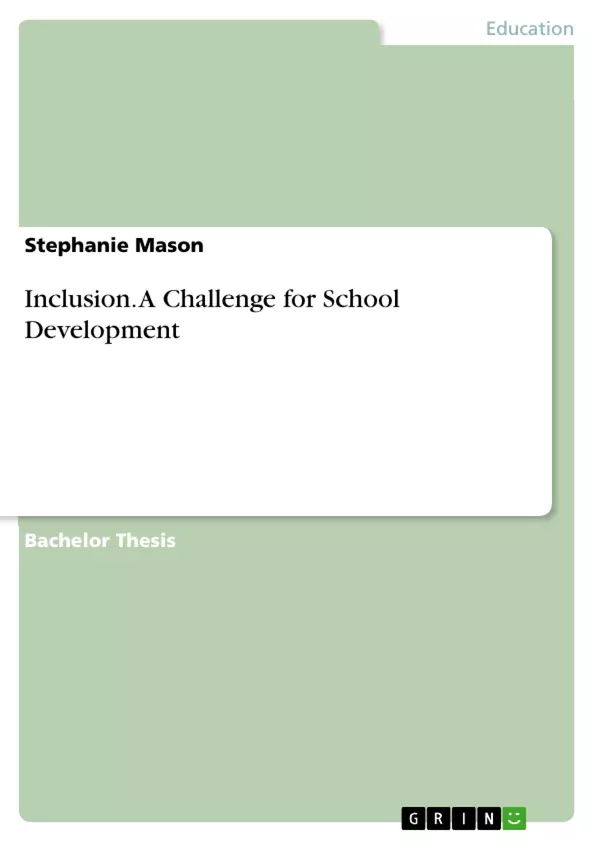This Bachelor's thesis on the topic of "Inclusion - A Challenge for School Development", after explaining important basics, takes a look into the future in the last chapter and pays special attention to the further development possibilities of the school system. The work was used to ask questions, to think visions and to give impulses: How does the school system have to develop further so that it can enable inclusion? What changes could make it possible for more pupils who were previously taught at special schools or support centres to remain at mainstream schools? What concrete implementation proposals and manuals for creating an inclusive school already exist and what are their possibilities and limitations?
Inhaltsverzeichnis (Table of Contents)
- Introduction
- 1. Explanation of terms
- 1.1 Education, educational equity and disadvantage
- 1.2 Heterogeneity
- 1.3 Inclusion
- 2. Historical review
- 2.1 General education and special education
- 2.2 Integration and inclusion before and after the Salamanca Declaration
- 2.3 Differences to integration and GU concept
- 3. A look into the future - further development
- 3.1 Further developing the school system
- 3.1.1 A binding model of inclusion
- 3.1.2 The "Index for Inclusion"
- 3.2 Developing the role of the teacher
- 3.3 Developing the role of the child in society
- 4. Concluding thoughts and summary
Zielsetzung und Themenschwerpunkte (Objectives and Key Themes)
This Bachelor's thesis aims to explore the concept of inclusion and its implications for school development in Germany. The work seeks to understand the challenges and opportunities presented by inclusion, considering its historical context and potential future developments. It also investigates how the school system, teacher roles, and student's societal participation should evolve to better accommodate inclusive practices. Key themes explored in the text include:- The definitions and nuances of education, educational equity, disadvantage, and heterogeneity.
- The historical evolution of general and special education, leading towards the integration and inclusion of students.
- The significance of the Salamanca Declaration in shaping inclusion policies and practices.
- The potential for further development of the school system to ensure a more inclusive environment.
- The evolving role of teachers and students in fostering an inclusive educational landscape.
Zusammenfassung der Kapitel (Chapter Summaries)
- Introduction: This chapter sets the stage for the thesis by highlighting the importance of ensuring equitable educational opportunities for all students. It emphasizes the need for a school system that empowers students to reach their full potential and effectively contributes to society.
- Chapter 1: Explanation of Terms: This chapter delves into the core concepts of education, educational equity, disadvantage, heterogeneity, and inclusion. It provides a framework for understanding the key terminology surrounding the inclusion debate.
- Chapter 2: Historical Review: This chapter traces the historical evolution of general and special education, examining how these systems have moved towards integration and inclusion. It highlights the pivotal role of the Salamanca Declaration in promoting inclusive education.
- Chapter 3: A Look into the Future - Further Development: This chapter explores the future of inclusive education in Germany. It focuses on the necessary developments within the school system, the evolving roles of teachers, and the importance of students' participation in society.
Schlüsselwörter (Keywords)
This thesis focuses on key concepts related to inclusive education, including educational equity, educational disadvantage, heterogeneity, integration, Salamanca Declaration, school system development, teacher roles, and student's societal participation. It investigates the implementation of inclusive practices in Germany and explores the potential for further development in the educational landscape.- Citation du texte
- Stephanie Mason (Auteur), 2012, Inclusion. A Challenge for School Development, Munich, GRIN Verlag, https://www.grin.com/document/1176548



